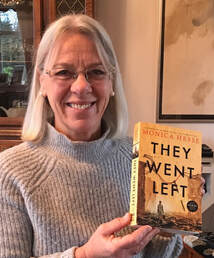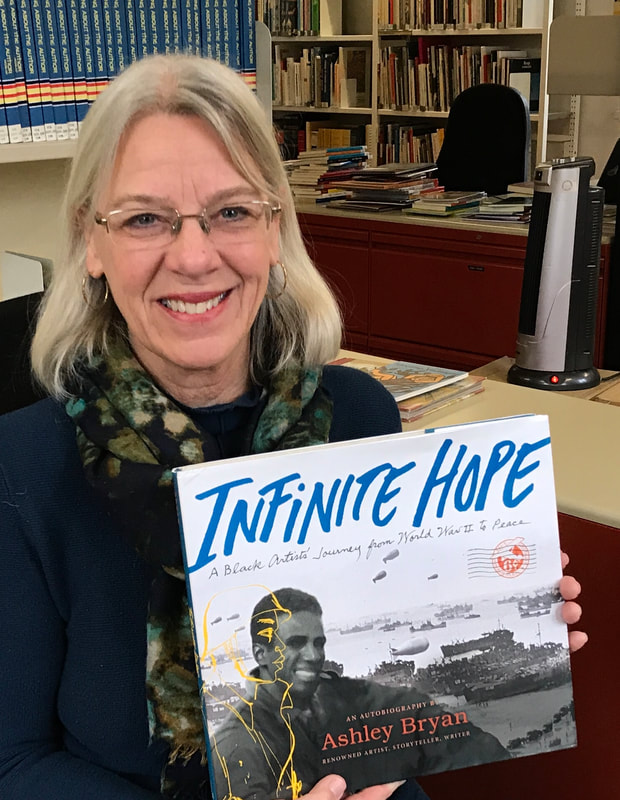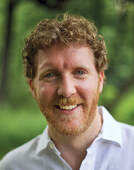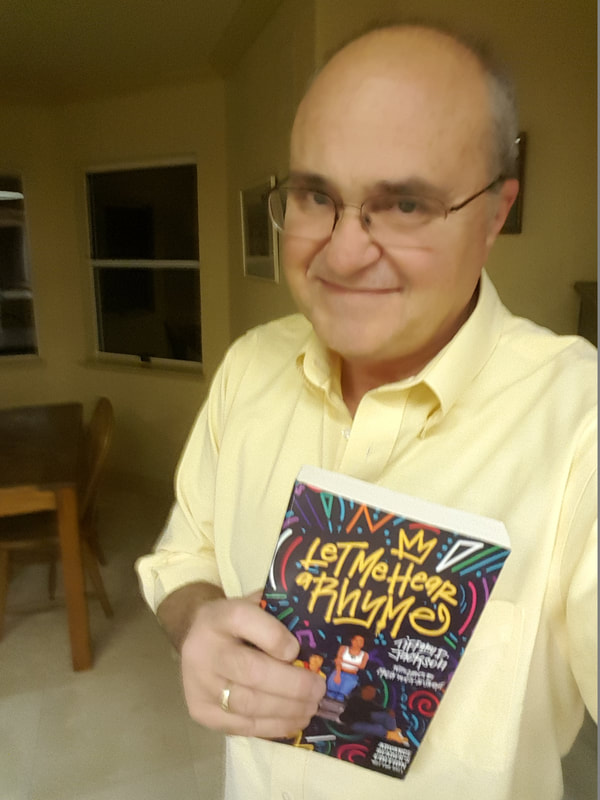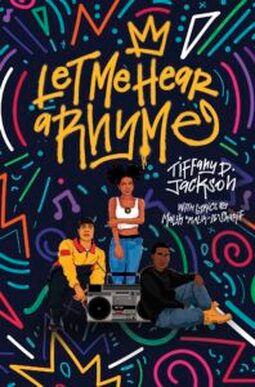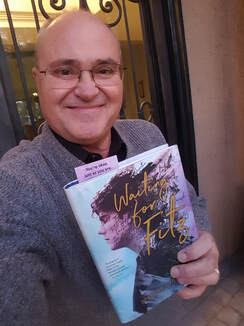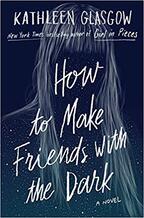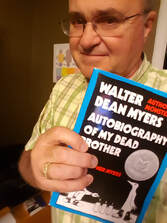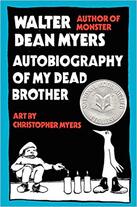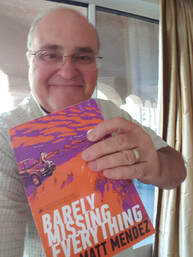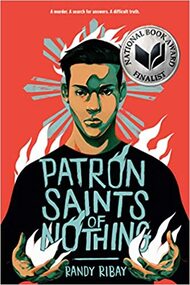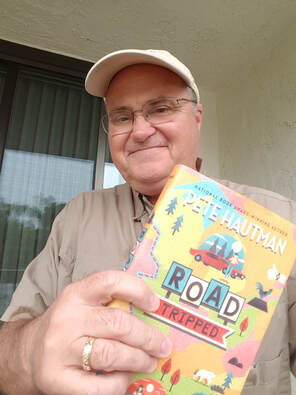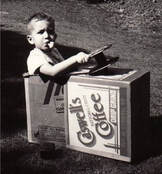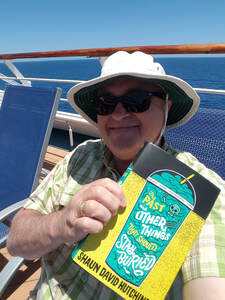Dr. Bickmore's YA Wednesday Weekend Picks
Are you looking for something to read? Pick one of these great books!
This is the new page. It begins with May 24, 2019.
For older picks click here.
You will find two years of interesting picks. There will be something there for you to love and share.
This is the new page. It begins with May 24, 2019.
For older picks click here.
You will find two years of interesting picks. There will be something there for you to love and share.
Weekend Picks for December 2019
by Nancy Johnson
Weekend Pick for Dec. 27
Everything you can imagine is real.
~ Pablo Picasso
~ Pablo Picasso
This Friday's Pick moves us closer to a new year, a new decade, and the acknowledgment that 2020 is not only an election year, it's also the 75th anniversary of the end of World War II. Choosing to focus a full month of Weekend Picks on literature set during this dark time in world history was a risk. Who wants to be reminded of the evils of war? Of notorious villains? Of death and dying? Especially during a holiday month! And yet, I know many teens who are keenly interest in WWII stories. I also know there are some new books (including some forthcoming titles in 2020) worth knowing.
|
The end of the year is the perfect time to reflect. This Friday's Pick invites historical reflection that reignites an examination of the human drama, the darkness, and the despair of WWII. But it also asks us to imagine the role of bravery and courage exhibited by everyday people, just like you, me, and your students. People who endure in spite of unimaginable hardship.
This coming April, Monica Hesse delivers They Went Left, another stunner of a WWII mystery that feels particularly appropriate to acknowledge 75 years since this war ended. I've read very few stories that begin when WWII ends, literature that raises the questions: Once the war is over, then what? How do you recover from the atrocities? Can you? In They Went Left, eighteen-year-old Zofia Lederman is still suffering the full horror of what she's endured. Nothing feels over for her, even though soldiers liberated the Gross-Rosen concentration camp where she survived. Three years earlier she and her younger brother, Abek, were sent right, away from the gas chambers of Auschwitz-Birkenau. Her parents, grandmother, and aunt were sent left. Not long after, Zofia and Abek were separated. |
Now that the war has ended and she has survived, Zofia is determined to fulfill the commitment made to her brother: Abek to Zofia, A to Z. When I find you again, we will fill our alphabet. What follows is Zofia's challenging journey through Poland and Germany, doing everything possible to find her brother. Eventually she settles into a displaced person's camp where she discovers she is not the only one trying to piece together their lives from a painful past.
They Went Left raises provocative questions about good and evil, trust and belief, love and family. As Hesse writes in her Notes on History and Research: "I don't know which is more unfathomable to me, the base evil and cruelty of the Holocaust or the undying hope that survivors managed to take out of it. I don't know which is more unfathomable, but I do know which we should aspire to."
Yes, this novel is deeply sad. It is also a remarkable celebration of survival that will likely propel valuable conversations. And, it will remind us all of the repercussions of war and the indomitable will of human beings.
They Went Left raises provocative questions about good and evil, trust and belief, love and family. As Hesse writes in her Notes on History and Research: "I don't know which is more unfathomable to me, the base evil and cruelty of the Holocaust or the undying hope that survivors managed to take out of it. I don't know which is more unfathomable, but I do know which we should aspire to."
Yes, this novel is deeply sad. It is also a remarkable celebration of survival that will likely propel valuable conversations. And, it will remind us all of the repercussions of war and the indomitable will of human beings.
A few other 2020 WWII-related novels to get on your radar include:
The Light in Hidden Places (by Sharon Cameron, forthcoming March 3) -- Sometimes heroes are ordinary people who do extraordinary things. Such is the suspenseful story of sixteen-year-old Stefania Podgorska, a Polish teenager faced with a difficult decision whether risk her (and her younger sister's) life to hide thirteen Jews in her apartment. Stefania Podgorska is an actual person in this truth-is-stranger (and often more amazing)-than-fiction story.
Village of Scoundrels (by Margi Preus -- forthcoming February 25) -- In another novel based on a true story, a group of teenagers in a remote village in southeastern France -- including a Jewish boy who learns to forge documents to save his mother -- participate in clandestine activities to resist the Nazis. Their skillful forgery and brave actions result in hundreds of lives saved.
We Are Not Free (by Traci Chee -- forthcoming June 9) -- This novel offers interconnected stories of fourteen teens, all second-generation Japanese American citizens who've grown up together in Japantown, San Francisco, but now find themselves incarcerated by their own country. Individual voices capture their unique stories, including their outrage and strength, as injustice threatens to splinter their long-time friendship.
The Light in Hidden Places (by Sharon Cameron, forthcoming March 3) -- Sometimes heroes are ordinary people who do extraordinary things. Such is the suspenseful story of sixteen-year-old Stefania Podgorska, a Polish teenager faced with a difficult decision whether risk her (and her younger sister's) life to hide thirteen Jews in her apartment. Stefania Podgorska is an actual person in this truth-is-stranger (and often more amazing)-than-fiction story.
Village of Scoundrels (by Margi Preus -- forthcoming February 25) -- In another novel based on a true story, a group of teenagers in a remote village in southeastern France -- including a Jewish boy who learns to forge documents to save his mother -- participate in clandestine activities to resist the Nazis. Their skillful forgery and brave actions result in hundreds of lives saved.
We Are Not Free (by Traci Chee -- forthcoming June 9) -- This novel offers interconnected stories of fourteen teens, all second-generation Japanese American citizens who've grown up together in Japantown, San Francisco, but now find themselves incarcerated by their own country. Individual voices capture their unique stories, including their outrage and strength, as injustice threatens to splinter their long-time friendship.
Weekend Pick for Dec. 20
While our art cannot, as we wish it could, save us from wars ... it can revitalize us amidst it all.
RAY BRADBURY, preface, Zen in the Art of Writing
I believe art ... is one of the things that could save us.
MARY OLIVER, The Christian Science Monitor, Dec. 9, 1992
RAY BRADBURY, preface, Zen in the Art of Writing
I believe art ... is one of the things that could save us.
MARY OLIVER, The Christian Science Monitor, Dec. 9, 1992
|
What saves us? What's worth saving? These two questions have rattled and resonated with each book I've read (and reread) about World War II for this month's YA Weekend Picks. And, it's these same two questions that compelled me to select children's book illustrator Ashley Bryan's visually-rich memoir, Infinite Hope: A Black Artist's Journey from World War II to Peace, as this weekend's pick.
But first, a brief introduction: Ashley Bryan is an active illustrator at 96 years old, a Newbery Honoree, winner of numerous Coretta Scott King awards, and recipient of two awards by the American Library Association for his lasting contributions to the field. He is known for his gentle, big-hearted spirit, his exuberant delivery of poetry, and his vibrant, color-filled illustrations bursting with radiant hues and joyful children. What he is not known for is his service as a soldier in the U.S. Army during World War II. But in Infinite Hope, Bryan tells this story, one that until recently was a secret even to his longtime editor. In May 1943, at the age of nineteen, Bryan's life as a student at Cooper Union Art School was interrupted when he was drafted into the U.S. Army. Assigned to serve in a segregated unit as a member of a Port Battalion, Bryan and his company landed at Omaha Beach on D-Day. For three years, he fought in World War II as a black soldier in a segregated army, enduring the atrocities of war and discriminatory treatment as a second-class citizen. “We were fighting a war in a segregated army to stop other people being treated as Other,” Bryan writes. Black soldiers were housed separately from white soldiers and restricted to labor and service jobs. He remembers riding with German prisoners of war: “We had to go sit in the back of the bus and they sat in the front of the bus, laughing.” Once the war ended, white troops were celebrated with fanfare and parades. Not so with the black soldiers, who often returned in twos and threes when there was extra room on a transport, and met only by their families. |
What saved Bryan during World War II, from training to the battlefield, was his art. He used every spare minute to grow as an artist, using charcoal and toilet paper, when his commanders confiscated his pencils and paper, and stashing his art supplies in his gas mask bag so it was always at hand. He drew and drew and drew, even when punishment threatened: “... the harder it was to draw, the more important it was to do it! ... If I had not had the love of art to back me up, I could not have made it. So much pain, and how could you take that? You have to have some way of surviving it.”
Infinite Hope is not a typical WWII memoir. Rather, it reads like visual storytelling and offers readers the intimate feel of a scrapbook. Photographs, handwritten letters, scribbled notes, journal entries with candid comments, honest observations, sketches and drawings offer a personal peek into history and the saving grace of art. Every spread in this oversized and unconventional memoir appears as assemblage, featuring overlapping areas of text with scraps of letters, photos, sketches and paintings, even postage stamps and ticket stubs. Rendered mostly in dark colors -- greys and blacks with subtle moments of color -- Bryan juxtaposes the ugliness of war and discrimination with the sustenance he experienced as an artist.
Infinite Hope offers readers of all ages a unique account of WWII, experienced through the eyes of a soldier of color and an artist of extraordinary grace. What saves us? What's worth saving? Perhaps it's making time for our gifts and talents and identities ... and sharing these gifts freely with others, even (and especially) during dire times.
Infinite Hope is not a typical WWII memoir. Rather, it reads like visual storytelling and offers readers the intimate feel of a scrapbook. Photographs, handwritten letters, scribbled notes, journal entries with candid comments, honest observations, sketches and drawings offer a personal peek into history and the saving grace of art. Every spread in this oversized and unconventional memoir appears as assemblage, featuring overlapping areas of text with scraps of letters, photos, sketches and paintings, even postage stamps and ticket stubs. Rendered mostly in dark colors -- greys and blacks with subtle moments of color -- Bryan juxtaposes the ugliness of war and discrimination with the sustenance he experienced as an artist.
Infinite Hope offers readers of all ages a unique account of WWII, experienced through the eyes of a soldier of color and an artist of extraordinary grace. What saves us? What's worth saving? Perhaps it's making time for our gifts and talents and identities ... and sharing these gifts freely with others, even (and especially) during dire times.
Some book pairings include:
Courage Has No Color: The True Story of the Triple Nickles, America's First Black Paratroopers (Tanya Lee Stone) -- This captivating narrative nonfiction examines the little-known history of the Triple Nickles, America’s first black paratroopers, who fought during WWII in an attack by the Japanese.
Fireflies in the Dark: The Story of Friedl Dicker-Brandeis and the Children of Terezin (Susan Goldman Rubin) -- The true story of how an art teacher with limited supplies brought beauty and fantasy to children in Terezin concentration camp, offering another story of how art saves, even if momentarily.
I Never Saw Another Butterfly: Children's Drawings and Poems from the Terezin Concentration Camp, 1942-1944 (Hana Volavkova, editor) -- References art teacher Friedl Dicker-Brandeis' art lessons to children in the concentration camps and showcases their creations.
The Port Chicago 50: Disaster, Mutiny, and the Fight for Civil Rights (Steve Sheinkin) -- A fascinating true story of the prejudice and injustice that faced black men and women in America's armed forces during World War II.
You Can Fly: The Tuskegee Airmen (Carole Boston Weatherford) -- This innovative history in verse celebrates the story of the Tuskegee Airmen through second person poems that celebrate the courage and contributions of their battles on two fronts.
Courage Has No Color: The True Story of the Triple Nickles, America's First Black Paratroopers (Tanya Lee Stone) -- This captivating narrative nonfiction examines the little-known history of the Triple Nickles, America’s first black paratroopers, who fought during WWII in an attack by the Japanese.
Fireflies in the Dark: The Story of Friedl Dicker-Brandeis and the Children of Terezin (Susan Goldman Rubin) -- The true story of how an art teacher with limited supplies brought beauty and fantasy to children in Terezin concentration camp, offering another story of how art saves, even if momentarily.
I Never Saw Another Butterfly: Children's Drawings and Poems from the Terezin Concentration Camp, 1942-1944 (Hana Volavkova, editor) -- References art teacher Friedl Dicker-Brandeis' art lessons to children in the concentration camps and showcases their creations.
The Port Chicago 50: Disaster, Mutiny, and the Fight for Civil Rights (Steve Sheinkin) -- A fascinating true story of the prejudice and injustice that faced black men and women in America's armed forces during World War II.
You Can Fly: The Tuskegee Airmen (Carole Boston Weatherford) -- This innovative history in verse celebrates the story of the Tuskegee Airmen through second person poems that celebrate the courage and contributions of their battles on two fronts.
Weekend Picks for Dec. 13
|
"History informs the present." -- Lawrence Goldstone
I grew up knowing nothing -- absolutely nothing -- about the internment of Japanese Americans in the 1940s. There was no mention of it in my history classes. No mention of it when we traipsed to the Puyallup Fair (now the Washington State Fair) each September, and admired the 4-H kids' prized animals, while gagging inside the stinky horse stalls. We were city-ish kids. White kids. Kids who believed that war was distant, in both time and place. We were kids -- and then teens -- protected from our own history, never thinking of Americans as "the enemy." And then, sometime in my 20s, I was introduced to Jeanne Wakatsuki Huston and James D. Huston's Farewell to Manzanar and America's history became far more complicated. Why didn't know about the internment "camps?" Why didn't I realize that the Puyallup Fairgrounds were once called Camp Harmony, a temporary facility within the internment camp system during WWII that housed Japanese American families in the horse stalls? What else didn't I know? Fortunately, today's readers have access to the complex history related to WWII in America. Farewell to Manzanar, a staple for many years in high school classrooms, is no longer the only book -- fictional, memoir, nonfiction -- telling the story of America's unjust treatment of her own citizens, and not just as a right/wrong narrative. Last year Monica Hesse's fictional The War Outside exploded my limited knowledge about the internment of Japanese Americans by introducing Crystal City, Texas as her setting. Who knew there was an internment camp for "enemy aliens" -- both Japanese-Americans and German-Americans -- suspected by the U.S. government of being spies? The War Outside is told through dual perspectives of two compelling teens, Haruko and Margot, who forge an unlikely, secret friendship while enduring indignities and tension in the camp and their families' personal challenges. It is a story layered with trust and distrust, one that invites us to reflect on what we believe about enemies. At one point Haruko tells Margot, “I’m so sorry…that your father had to wake up and realize that you had become the enemy overnight. But at least you didn’t have to wake up and realize that other Americans had thought of you as an enemy all along.... You can’t hate someone all of a sudden. It takes practice. It takes a long time” (148). The War Outside weaves in threads of mystery and betrayal and offers an "oh wow!" ending resonant with the heartbreak of unexpected loyalty. This fall, actor and activist George Takei (with co-writers Justin Eisinger and Steven Scott and artist Harmony Becker) published his graphic memoir, They Called Us Enemy, recounting his childhood years following President Franklin D. Roosevelt's signing of Executive Order 9066. Outraged by current U.S. government policies, in particular the treatment of asylum seekers, and believing history is being repeated, Takei writes: "... my unexpected notoriety has allowed me a platform from which to address many social causes that need attention" (189). This platform and his believe that "old outrages have begun to resurface. . . with brutal results" (197) compelled him to write and speak about his own family's incarceration at the hands of the U.S. government. They Called Us Enemy presents Takei's very personal account of his family's forced incarceration first to the horse stalls at the Santa Ana Racetrack, then to the Rohwer Relocation Center in eastern Arkansas, and eventually to Camp Tule Lake, a maximum-security segregation camp. The graphic novel format -- accompanied by Takei's childlike memories, at times joyful and other times terror-filled -- serves to show (and tell) the effect of injustice as Japanese Americans were rounded up during WWII. The book offers stark contrasts: images of days-long train rides across country in sweltering heat with no amenities, scenes of suit-wearing politicians in the White House and Senate administering bills and passing discriminatory laws against American citizens, illustrations of George and his family tossing snowballs and experiencing the magic of snow, images of the tear-streaked faces as families are separated. Becker's illustrations effectively showcase the tension and emotion of the adults as they aim to preserve their dignity and commit to keeping their children innocent and unworried. They Called Us Enemy offers moments of innocence and humor and glimpses into humanity and inhumanity as Takei navigates and interprets memory and lays is alongside current discriminatory policies. This is not a memoir of outrage. Rather, it's an evocation of courage and country, a commitment of loyalty and love, and a son's tribute to a daddy who believed deeply in a people's democracy. A few book pairings include: Enemy Child: The Story of Norman Mineta, a Boy Imprisoned in a Japanese American Internment Camp During World War II -- During WWII, nine-year-old Norman Mineta -- who became Congressman Mineta (and appears in Takei's memoir) -- and his family was imprisoned at the Heart Mountain internment camp in Wyoming. Andrea Warren's well-researched biography offers a realistic and empathetic picture of life in the camps. A Place to Belong -- Taking place at the end of WWII after the passage of H.R. 4103, this novel tells the story of one family's expatriation to Japan after they renounce their U.S. citizenship (referenced in They Called Us Enemy). This move to a country they have never known is experienced through a young girl in Cynthia Kadohata's truth-filled historical fiction. |
Weekend Pick for Dec. 6
|
"People are at their best in the face of tragedy." -- Deborah Heiligman, 2019 NCTE
I first read Deborah Heiligman's Torpedoed: The True Story of the World War II Sinking of "The Children's Ship" as an ARC this summer and, after hearing her speak at NCTE and the ALAN workshop a few weeks ago, I re-read it with fresh insight and deeper appreciation. Like compelling fiction (which it is not!), this page-turner tells the harrowing you-can't-make-this-up true story of ordinary people under extraordinary circumstances. And, as Heiligman reminded us at NCTE, it shows us how tragedy can -- and did -- bring out the best in people. Torpedoed tells the extraordinary account of the passengers on the SS City of Benares, including over 100 children, most being evacuated from England as part of the CORB Program (Children's Overseas Reception Board). Some of the children traveled with siblings and all were accompanied by a head escort and chaperones. It was a to be grand adventure -- a passage to safety from increased German bombings -- on an ocean liner with luxurious furnishings and all the ice cream the children could eat. Once on board "the children felt they were richer and luckier than they could ever have imagined" (24). But their luck turned into tragedy when a German U-boat torpedoed the Benares in the early hours of the morning, within days of leaving Liverpool. Heiligman tosses her readers into the frigid waters, and creates vivid images of survivors clinging to lifeboats as well as children and crew who fell, drowned, or were killed on impact. At the ALAN workshop Heiligman reminded us: "The truth matters, even when it's painful. Young people want to hear the truth: sad, tragic, heroic, life-sized and larger than life." Torpedoed tells us the truth. The truth of what happens during war. The truth of children and adults doing whatever it takes to survive. The truth of the Benares's Indian crew, the lascars, many who gave their lives to save the passengers, even though their names were never recorded. I was chilled to the bone while reading Torpedoed, frantically turning the pages to seek good news. I cheered when the last lifeboat was hoisted onto the Royal Navy destroyer HMS Anthony and I grieved the loss of the children, the passengers and the crew who did not survive. Because of Heiligman's compelling storytelling, I also ached for "the enemy" when I learned that Heinrich "Ajax" Bleichrodt, the young commander of U-boat 48, suffered a mental breakdown upon discovering the Benares was filled with children. Heiligman's four years of research that included interviews with two survivors, ship records and passenger lists, naval reports, letters, journal entries, photographs, memoirs of U-boat sailors, autobiographies, newspapers, and "field trips" to England to see and read the remaining artifacts from this tragedy are woven into the telling of this true story. Extensive back-matter confirms the accuracy and authenticity of Torpedoed. Whenever I hear that the market is saturated with WWII stories, or that children and teens don't want or need more stories about pain and death and the unspeakable horrors of this time period, I come across books like Torpedoed and I am so grateful for impeccable researchers and riveting storytellers who remind us there are more stories to tell. More people to meet. More examples of sacrifice and loss, courage and heroism in the face of being "torpedoed." Note: Yesterday Torpedoed was announced as a finalist for the 2020 YALSA Nonfiction Award, to be announced on January 27th. Two possible book pairings for Torpedoed include: ~ Lifeboat 12, Susan Hood’s historical fiction novel novel-in-verse, offers a fascinating companion story about the sinking of the SS City of Benares and is ideal for middle school readers. This novel focuses on Ken Sparks and the five other boys in Mary Cornish's lifeboat. ~ Ruta Sepetys' Salt to the Sea tells another story of a passenger ship being torpedoed during WWII. This novel braids four characters' stories as they flee Russian soldiers occupying East Prussia in 1945 and are torpedoed on the Wilhelm Gustloff, ferrying people across the Baltic Sea |
Weekend Picks for November 2019
Weekend Pick for Nov. 29
|
One of the fun parts of NCTE for me is chance to meet new people. I had the opportunity to share a dinner with Brandy Colbert and several others (thanks Little Brown.) Brandy is the author of Little and Lion, Pointe, and various short stories. I had the chance to hear talk first hand about her new book. The Revolution of Birdie Rudolph. Once again, I had a book that moved to the top of my "to be read" list. Brandie does not disappoint.
Birdie is a typical, success oriented young women who still wants to spread her wings a bit. She loves her parents, loves school, and loves Booker. While there might be a way in the cosmos that all of these "loves" would align, Birdie doesn't see how. In a revolution of any magnitude someone is bound to get hurt. About ten years ago, I was giving a presentation with Melanie Hundley at the Association for Middle Level Education and we asked if any one could think of any books with middle class black suburban characters. A decade ago that was a difficult ask. There were a few, but not many. That topic is a food for a full blog post in the future. Brandy's books are part of a wave of books that are expand what we have to choose from. Keep at it. |
Weekend Pick for Nov. 22
NCTE Break
Weekend Pick for Nov. 15
|
I know many of you are looking forward to NCTE, but I am looking forward to discussing Bredan Kiely's The Last True Love Story on Tuesday. This is one of those books I like to talk about all of the time. It is in great company, I have done that with We Were Liars, The Impossible Knife of Memory, Too Shattered for Mending, and Climbing the Stairs. So, you can see it is in good company. (by the way checkout those titles if you don't know them.
Brendan's book is perfect for you if you favor a more traditional approach in the classroom and like to lean toward the classics before including YA fiction. Homer's Odyssey is a major pattern for this story. It is a journey into memory as well as a physical journey to Ithaca, NY. In the story, the main character, Hendrix, tries to help his Grandfather hold on to the memory of his wife has he slips deeper into Alzheimer's decease. A causal reader might see this book as a simple love story between Hendrix and Corinna, complicated by Hendrix's relationship with his grandfather. The names alone should give you a hint that this journey will also be immersed in music. Music permeates the story and any YA book with reference to Van Morrison is at the top of my list. |
Weekend Pick for Nov. 8
|
Tiffany Jackson continues to amaze me. Reading both Monday's Not Coming and Allegedly were profound experiences. I recently finished Let Me Hear a Rhyme, and it is another unique reading experience. I read a lot of books every year, but reading all three of Tiffany Jackson's books in one year has left me considering this young author to be one of the most gifted writers emerging today. She not only should be read, she needs to be read. None of her books are easy reads. By that statement I mean that they are emotional and full of power. Indeed, both Allegedly and Monday's Not Coming are often painful to read. The truth of the matter is that adolescents often live in and try to cope with a difficult world.
Let Me Hear a Rhyme is a bit lighter, but still wrapped around a murder. This book will be included in the discussion of the Hate U Give, Dear Martin, Ghost Boys and many others that have been popular recently. I believe it should be, but it is not the only reason to read the book. I think you should read it because it completes a trio of books that are remarkable. I say it all of the time-- YA literature is real, serious literature. Sure there are books in the YA classification that are light or not very good, but some of it is outstanding. Many of us work to treat this literature seriously everyday and will continue to make those efforts in our research, advocacy, and our teaching. In my opinion, Tiffany Jackson has the hat trick. Three books that are worthy of your attention, worthy of your critique, and that should be include in your syllabus. |
Weekend Pick for Nov. 1
|
I know next to nothing about mental illness or other ways that teens are categorized with disabilities. I do know that I had many students over the years who suffered in one way or another. I tried to help, to be understanding, to listen to their and the professionals. With YA literature in this area I differ to several colleagues--Kia Jane Richmond, Diane Scrofano, and Patricia Dunn (All three have studied the issue in one way or another and have written for the blog. There names are linked to a post.)
I have been reading a ton to get ready for the ALAN Workshop. One of the books that has stuck with me is by Spencer Hyde. His novel, Waiting for Fitz was recommended by Chris Crowe. Trust me, I am in the habit of trying to listen to the sage of advice of Dr. Crowe. Waiting for Fitz had me from the beginning. Hyde does not his experience has some who has been treated for an OCD condition as an adolescent, but he is clearly writing from his experience. One of the characteristics that I like most about this novel is the character development--not just of Addie and Fitz, but the other adolescents and of the adults in the novel. Well done, Spencer. I am excited about the opportunity to hear from him at ALAN. In addition, Spencer will be signing in the ALAN booth during the last day of NCTE. Make sure to come by and say hello. |
Weekend Picks for October 2019
by Shelly Shaffer
Weekend Pick for Oct. 25 by Kaila Shaffer
|
Roar by Cora Carmack
Very few books have had the ability to completely submerge me into their worlds. This book falls on that list and I did not want to leave the world that was beautifully crafted by Cora Carmack. This book follows the journey of princess, Aurora, in the land of Caelira. In this land the royalty is distinguished by their magical ability to fight violent magical storms that riddle the land; thus earning themselves the name of Stormlings. Aurora, however, was not born with the same powers as the rest of her family, forcing her into hiding her true self to preserve the throne. When an unwanted betrothal is looming like a storm in Auroras future, she sets on a journey to gain the magic she has so desperately wanted her whole life. |
|
Every page was captivating whether it was with romance, danger, or the journey. I wasn’t able to set the book down; I even lost sleep staying up to read just one more chapter. We’ve all been there, right? Devouring this book was a luxury and once it ended I needed seconds. I ran to the closest bookstore I could find at 9 p.m. to buy the second book in this unforgettable series. I then recommended Roar to my mom; once she finished it even she couldn’t resist starting the next. She even “stole” it from my bedside table while I was at work because of how alluring Cora Carmack spun this fantasy.
|
Weekend Pick for Oct. 18
|
The Last to Let Go by Amber Smith
What happens behind closed doors? Often, domestic violence is hidden, unspoken… but the long-term effects on those involved is exponential. Brooke Winters’ life is shattered after domestic violence results in her dad’s death and her mom’s incarceration. As PTSD haunts Brooke and her two siblings, she has to decide if she can break away from the cycle of violence. Brooke Winters has just completed her sophomore year and as she heads home from her last day of school, she’s surprised to see her apartment building surrounded by police cars, a fire truck, and an ambulance. Brooke’s first thought is her mom. He finally did it. He finally killed her. But, she’s surprised to see her mom being led out of the apartment in handcuffs. What happened? The life Brooke has known and has been hiding for so long will never be the same. As her mom sits in jail awaiting trial, Brooke and her siblings try to live. Brooke struggles to regain normalcy, and her siblings begin to move forward—make new dreams and new lives for themselves. For Brooke, returning to their apartment, staying together no matter what, is the ultimate goal, but as it begins to fall apart, Brooke has to decide if she can let go of her old life and move on. Through a tough examination of what’s important, Brooke learns to love herself and her new life and ultimately learns to let go. |
Weekend Pick for Oct. 11
|
Rebel Girls by Elzabeth Keenan
“So what if she did?” “So what if she didn’t?” Can we really fight against rumors? What do we do when those rumors challenge our beliefs? Elizabeth Keenan’s Rebel Girls takes us to Baton Rouge in 1992. The main character, Athena Graves, is a self-proclaimed feminist who is definitely on the outside at her private, conservative Catholic high school. After spending the summer with her mom in the Northwest, Athena and her sister, Helen, return to find that a malicious rumor has been spread about Helen: that she had an abortion over the summer. Whoever has spread this rumor knows that the Catholic high school can expel a girl who goes against their faith’s pro-life stance. Helen has to figure out a way to help Helen without betraying her own beliefs about pro-choice and feminism or Helen’s beliefs about pro-life. With the help of her staunchly feminist friends and classmates, Athena launches a campaign to clear Helen’s name. The group creates campaign pins to garner support for their cause proclaiming, “So what?” Eventually, the girls come up with a plan that will help clear Helen’s name and to take down the bullies who started the rumor in the first place. Rebel Girls provides a viewpoint on how activism can happen even when the odds seem stacked against you. This inspiring story illustrates how one small action, taken by a small group of students, can change the lives and culture of a school. These “Rebel Girls’” voices were heard, and they made a difference. |
Weekend Pick for Oct. 4
|
Sepetys once again writes a masterful story that takes readers into an obscure, painful historical event.
The Fountains of Silence takes us to Madrid, Spain during dictator Francisco Franco’s rule (1939-1975). This book follows four main characters, Rafa, Ana, Daniel, and Puri, during the summer of 1957. Daniel is an American tourist from Texas, who meets Ana, who works in the hotel where he’s staying. As he gets to know Ana, he meets her cousin, Puri, who works at an orphanage, and her brother, Rafa, an amateur bull-fighting promoter. The four main characters provide distinct points of view, illustrating how Franco’s tyranny impacted families in Spain, and how much was hidden from outsiders. Spain in 1957 looks bright and shiny to the tourists that are flooding into Madrid, but teenage tourist Daniel Matheson sees beneath the sunny façade as he uses photography to capture the ugly truth hiding beneath the glossy veneer. Arriving in the city with his oil tycoon father and his Spanish mother, Daniel witnesses firsthand the fear that seems to oppress Madrid’s Spanish citizens. As a United States citizen, the lack of freedoms the Spaniards must live with surprises (and terrifies) Daniel when he gets in trouble for taking forbidden photos of the Guardia Civil. Daniel’s curiosity takes him deep into Madrid, to places tourists rarely go, and readers see Ana’s family’s poverty in stark contrast to Daniel’s wealth and privilege. This book conveys the tension and fear those living in Madrid faced on a daily basis, from missing babies, to threats by the Guardia Civil, to trying to Before reading this book, I didn’t know about Franco’s dictatorship. I knew nothing about the oppression citizens in Spain experienced from 1939-1975; I knew nothing of how Catholicism was upheld as the national religion; and I knew nothing about how little control Spaniards, particularly women or those opposed to Franco, had over their own lives. The reader experiences the disappointment, heartbreak, and hope along with the characters. Sepetys’ storytelling brings this book to life, even for readers who do not have the background on Franco’s Spain. Throughout the text, Sepetys’ inclusion of vintage media interstitials, oral history commentary, photos, and more provides the readers with additional background for events in the book. |
Weekend Picks for September 2019
Weekend Pick for Sept 27, 2019
|
About a year and half ago I read a beautiful but heart wrenching book. I hope you know the kind I mean. It was so wonderful that you are thrilled that you have read it and at the same time you can barely belief that the author was able to write about emotions so openly and honestly. They still felt raw and immeditate. That book was Girl in Pieces by Kathleen Glasgow. I have been patiently waiting for her next book. Well, it is her and it is wonderful. A few weeks ago I finished It and I knew it would be a weekend pick. How to Make Friends with the Dark is a frank look at loss and grief. In addition it confirms what some of us have been hoping for; a second novel that proves that Kathleen Glsogow's talent is real and here to stay. If you were a fan of her first book then you have a treat waiting for you. If you missed Girl in Pieces. Do youself a favor and grab both of these books as soon as you can!
|
Weekend Pick for Sept 6, 2019
|
When good men do nothing...
How many of us have heard that saying? I have, many times. Honestly, over the last two years I have wondered if I am doing enough to counter bad in the world. True, I work with future teachers and those I am working with now will work with students whose work and influence will directly touch the next century. Students in the first grade now will be 87 in 2200. The heroine, Sophie Scholl, of White Rose would be 102 today had she not been executed. Something tells me that her tenacity would have provided her a long life had she been allowed to live. We have student activist throughout the world who are working on gun violence, global warming, social justice, hunger, etc. When they are 80, 90, or 100 will be able to say we responded appropriately? Will they or will we be able to bear witness to positive change? Will we stay silent? Will we help them address increasingly contentious issues--immigration, endless wars, intense poverty? I don't have all of the answers, in fact, maybe I don't have a single one. But, I can support free speech and "real" news. The student movement know as White Rose protested Hilter and the Nazi movement through a leaflet campaign. Free Speech. Plain and simple. No protests, no violence. Just voices protesting a useless and increasingly devastating war and the accompanying acts of genocide. This historical fiction, verse account imagining the thoughts and conversations of Sophie and her associates is tragic and, yes, a quite painful. The war ended, but many good men and women did.....nothing. |
Weekend Picks for August 2019
Weekend Pick August 30, 2019
|
You know you like a book when you have owned it with at least two different covers and you have passed on at least three copies. It is still one of my favorite books by the estimable Chris Crutcher. i love the books directness. Believe it or not, when I am facing something difficult in my own life, this is one of the books I think about. As sappy as it may sound, I still find the book inspirational.
In fact, I still find Chris Crutcher inspirational. If there is a bigger advocate for children and adolescents, I am not sure who it would be. Often, his novels contain veiled retellings of stories that he has heard first hand from those who have experienced them. Young people are often strong and resilent, but it doesn't mean don't advocate for them, protect them, and believe them when they tell us sensitive information. It was probably difficult to share. Without a doubt, this is a novel about sports that is about significantly more that sports. It is about character, persistence, and plain grit. This is always one of my go to suggestions for kids who say they "don't like to read." If you know the book remember to pass it along. If you don't know it, threat yourself to something special over this long weekend. |
Weekend Pick August 23, 2019
|
This is another book that stays with you. I was introduced to this book right as it came out several years ago. I have been book talking this book ever since. For those of us who grew up under the shadow of the Viet Nam War it is a reminder of how present the war was in the American psyche for a decade or more. We worried about the draft. The death count was constanty present. We had friends whose older brothers were off fighting. The music and the culture constantly reflected the issue.
Chris Crowe has been one of my constant mentors as and English educator. In addition, to that work he has written YA fiction and nonfiction. During his career he has managed accomplishments that I just look at with amazement. This book is an homage in verse to those who served and sacrificed. I don't want to produce any spoilers. So, enough said. It is time for you to click on the images and get a copy of the book. |
Weekend Pick August 16, 2019
|
I don't know about the rest those who teach classes focusing on young adult literature, but from time to time I find an author that I feel compelled to champion. I talk about their work all of the time, I connect their work with the work of other authors. I assign their book in classes. I blog about it. I even try to tell the author directly how much the book means to me and how I think the book is a contributing facet of the larger landscape of YA lit.
One of those writers is Maria Padian. I loved her novel Wrecked from the very first page. I am deeply gratefully to Trevor Ingerson, who knew me just well enough to send me the book with a hand written note. The note made a difference. The book moved to the top of the "to be read" list. Wow! Needless to say, I was thrilled that Maria's publisher pitch her as an author for this year's ALAN Workshop. I received a copy of her newest book, How to Build a Heart, with enthusiasm. Not only does the book have a beautiful, intriguing cover; the main character Izzy, is a force. This character's journey is captivating. I found myself turning down pages (Yes, I am one of those if I own the book.) so that I can return and reread passages. Yip, this is one of those books I will be wandering through more than once. |
Weekend Pick August 9, 2019
|
I am doing something different for the weekend pick. I have selected a piece of nonfiction. whenever I need to think about how to think about race--which is all of the time-- I am remineded of my privilege and my whiteness. I often what to say something, but i know I should listen most of the time--maybe all of the time.
To guide me, I have been reading and rereading Playing in the Dark by Toni Morrison. I have been traveling for two weeks. One of the things I shoved into my crowded backpack was this gem. I had no preminession. I just knew I would be thinking and write about race a bit. When I heard the news of Morrison's death I was saddened as many of you were. I used to teach Song of Soloman from time to time. I included A Mercy in the first graduate class I taught (isn't really an advance YA novel?). I will miss her voice from time to time, but the book will be there. When I get home, I will start the Song of Soloman once again. |
Weekend Pick August 2, 2019
|
To read a book by Walter Dean Myers is to recieve a gift and to participate in the founding moments of Young Adult literature. To read one of his books written during the last decade of his life is to revel in greatness. If you also read one illustrated by his son, Chrisopher, you hit the jackpot.
Myers' Autobiogrpahy of My Dead Brother is a masterpiece of YA Lit and one of his three books that were finalist for the National book Award, the other two are Monster and Lockdown. All three books are worth a know and knowing well. Each one deserves a second and a third reading. Myers is truely one of the great authors in the YA classicificaiton and his works, both the novels and some of his opinion pieces specific the importance of "own" voice in literature for adolescents. |
Weekend Picks for July 2019
Weekend Pick July 26, 2019
|
Some authors just sing to you. You read one of their books and then you want to read another as soon as you can. I like to spread around the weekend picks, but I got a chance to land a copy of Tiffany D. Jackson's first novel--Allegedly. This book rocks. I had to feature it right away.
Let me be clear, it is not an easy book to sit with and contemplate. The themes, the characters, and the style are demanding. It explores family dynamics, the youth criminal justice system, social services workload, and teen pregnancy. In addition, all of these themes are situated in ambiguity and doubt. What is true and what is imagined is constantly in play. Who is in danger and who is dangerous is never quite clear. The main character, Mary, is clearly drawn, but what she know about events, herself, and others is uncertain. What others state about events is only alleged. What is certain is that Tiffany D. Jackson is a rising star. Read Allegedly or any of her books and join the fan club. |
Weekend Pick July 19, 2019
|
The Book of Joshua is a great book. You will love it and you will hate it. You will love it because the characters are real and engaging. You will hate it because the issue of mental illness is real and you might not know what to do about it. You might know somebody who suffers, you might suffer yourself, and the teachers or students you might work with could be living with some one who struggles. There are a large number of place to get help, here is one: https://www.nami.org/Find-Support/NAMI-HelpLine/Top-HelpLine-Resources
With The Book of Joshua, Jennfer Anne Moses has created a text that will resonate with readers. As a side note, this book came to me through Jerry Weiss. Jerry Weiss in one of the very early scholars of YA Literature. Early on, I learned that if Jerry recommended something it was worth a second look. Well, the book is worth a first, a second, and a third look. This book will probably not get a lot of press. It should it is as good as, if not better than, most books I have read on the topic--Including the acclaimed Turtles all the Way Down. I do hope people read the books I highlight in the weekend picks. At the same time, I rarely state outright that some one should buy a book. Well, I think that you should buy and read this book. I am not a judge about whether or not Moses gets it all right. I will leave that discussion for others. What she does get is the emotion and exsposure to the issue. Get the book, read the book, and we can begin to have a larger conversation. |
Weekend Pick July 12, 2019
|
I am a bit late this week, frankly I was just too busy having birthday fun.
Matt Mendez has really made an impact with Barely Missing Everything. I was completely impressed by the artistry of this wonderful debut novel. As I have mentioned on many other occasions, I love realistic YA fiction that is generally intended for older adolescents. He skillfully weave the action of the three main character, Juan, Fabi, and JD as we learn who they are, the details of their desires, their mistakes, and the steps they thinking they are taking in order to move forward in life. Mendez does not shy away from the difficult conversation or relationships. These characters will stay with you, their problems and actions will give you pause. This an author to follow. I am absolutley looking forward to what he does next. |
Weekend Pick July 5, 2019
|
I like reading YA fiction the includes music. Books that reference a lot of music, books that show kids exploring music, kids in bands, etc. I love the reference and the sound track that develops as I read. Think King Dork, Sorta Like a Rock Star, Breakout, Born Confused, and The Last True Love Story.
Tara Kelly has another one that should be added to the list. I love the energy of this book and should have picked a long time ago. It is perfect summer read. It will make you want to pick up an instrument or build another playlist of song you haven't thought about in awhile. In Amplified, Jasmine decides to take a gap year--at least-- and follow her dream to become professional musician. What could possibly go wrong - or right. |
Weekend Picks for June 2019
Weekend Pick June 28, 2019
|
Randy Ribay's fiction is quite new to me. I was introduced to After the Shot Drops about 8 months ago. I really liked the book and had short listed it for a future weekend picks. A few weeks after that I received an advanced reading copy Patron Saints of Nothing and moved it to my TBR stack (a stack that is currently too big).
Shortly after that I was having dinner with Laurie Halse Anderson--Okay, don't panic, I was one of about six people. She was back in Las Vegas for another event. I love asking author who they think I should be reading. Well she was carrying around Patron Saints of Nothing and began to rave about this book. It moved up the list. In the spirit of continuing my arm chair travels. I urge you to get this book. Randy's narrative voice is strong and sure. I love how the two books were different yet the strength of the writing let you know that you were find an author that you wanted to watch grow. In this pick he takes unflinching look at the current culture of law enforcement in the Philippines. Many of us work in communities with vibrant Filipino communities, yet we might know very little about their home country or the ways they remain connected. Take a look. |
Weekend Pick June 21, 2019
|
It is summer time and the livin' is easy. Well, like many of you it is summer and I have things to do, summer classes to teach, a few writing deadlines to meet, and a conference attend.
But, most importantly, there are books to read. Oh, and every once in a while their is a vacation to take. Dare we say a road trip! Pete Hautman, the author of the National Book Award winner, Godless, has a great new novel perfectly time for all of the fun and sun the novel has to offer. Road Tripped in not only a journey down America's road it is also journey into the past. Hautman has created a novel that let's us travel with Stiggy as he tries to discover what he has lost and, ultimately what he starts to find. |
Weekend Pick June 14, 2019
|
Okay, I readily admit it. I am an Andrew Smith fan. Many of you are huge fans of Winger or Grasshopper Jungle. I like those as well, but I think my current favorite is a 100 Sideways Miles (a weekend pick Aug. 11, 2017). I waited for a while to get his newest book, The Size of the Truth, marketed as a Middle Grades book, (Excuse Me!). I wondered about Andrew Smith and what it would look like for him to write with his tone, wit, and style for the middle grades audiences. Well, (Excuse Me!), he hit it out of the park. Once again Smith pulls out all of the stops to create an absurdist novel that will resonant with the intended audience and still hit all of the right notes for the rest of his readers. An armadillo that masquerades as a unicorn, bats that speak in unison, and a friendly, but sneaky coyote named Audrey. Okay, that is absurd enough, but Sam Abernathy meets all of these character when he is four years old and stuck at the bottom of a well for three days.
This book is a home run, but not because of all of the wonderful absurdity, but because of the remarkable pathos. Sam has repressed these memories until he finds himself promoted from elementary school directly into the eight grade (Excuse Me!). Where you have to strip naked (Excuse Me!) in front of everyone. He has to share a locker with James Jenkins and older boy who caused his fall into the well (Excuse Me!), that just doesn't seem fair and it is scary. Thrown together, they fall into an understanding and a friendship. It is time to celebrate with a trip to the ballet and a gourmet dinner of Macaroni and Cheese. Read this book as soon as you can. |
Weekend Pick June 7, 2019
|
Like many of you I have been hearing all of the buzz about a talented "new" author, Tiffany D. Jackson. Well, folks the hype is real. I loved Monday's Not Coming. If you like Jason Reynold, Kekla Magoon, Walter Dean Myers, Nic Stone, Angie Thomas, Sharon Draper, and... Well you get the idea. I loved the realism of the narrative. The character of Claudia will break your heart.
The pace of this novel unfolds in ways that will keep you engaged in the narrative. You join Claudia in the search for her friend. As she explores, you explore. If you need a book that will push you in how you think about poverty, take a look. |
Weekend Picks for May 2019
Weekend Pick May 31, 2019
|
The 2019 Summit on the Pedagogy for YA Literature finished yesterday. Several presenters mentioned the edited book how to teach and talk about gun violence in the ELA classroom. It was the work of Shelly Shaffer, Gretchen Rumohr-Voskuil, and myself for about 7 months. In the original outline we had planned to write a joint chapter about this week's pick, People Kill People by Ellen Hopkins. We pushed it to the side as an article due to page count and the other wonderful chapters written by others. (Okay, Shelly and Gretchen, it is time to clean up this project.)
Yesterday, I had the fleeting thought about the weekend pick for today. I thought--Surely, I have featured Ellen book. But, I have not. This is a a wonderful book. It gets at the some of the issues around gun violence in interesting ways. The characters are multifaceted and engaging--and occasionally a bit terrifying. Check it out. |
Weekend Pick May 24, 2019
|
I had a fun read for a week on a cruise. Once again Shaun David Hutchinson doesn't disappoint. His bizarre, surrealistic take on the world provides a look at friendship that readers won't soon forget.
The dead don't die, but they don't Zombie around looking to eat people either. July and Dion have unfinished business before July can get on with the task of dying. Or, maybe Dion needs a push so he can go about the work of living. Breaking up a romance has it challenges, but ending a "best" friend relationship can be devastating. If you haven't read one of Shaun's books before you are missing out. Don't worry--This standalone novel, The Past and Other Things that should Stay Buried, fits the bill for a perfect introduction the work of this engaging author. |

